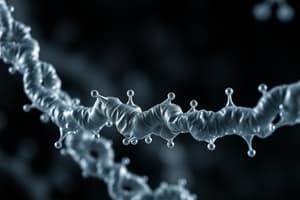Podcast
Questions and Answers
What is the term for molecules produced by living organisms that are essential to biological processes?
What is the term for molecules produced by living organisms that are essential to biological processes?
Biomolecules
What type of biomolecules are thought to be the most abundant and are excellent providers of energy?
What type of biomolecules are thought to be the most abundant and are excellent providers of energy?
Carbohydrates
How are simple carbohydrates different from complex carbohydrates in terms of digestion and glucose release?
How are simple carbohydrates different from complex carbohydrates in terms of digestion and glucose release?
Simple carbohydrates are digested quickly and provide immediate bursts of glucose, while complex carbohydrates are digested more slowly and supply a slower release of glucose.
What essential role do carbohydrates play in the human body?
What essential role do carbohydrates play in the human body?
What are some benefits of consuming carbohydrates?
What are some benefits of consuming carbohydrates?
How do carbohydrates help in preventing diseases?
How do carbohydrates help in preventing diseases?
What is the role of plant fiber in reducing the risk of cancer?
What is the role of plant fiber in reducing the risk of cancer?
How do monosaccharides like Glucose and Fructose contribute to carbohydrates?
How do monosaccharides like Glucose and Fructose contribute to carbohydrates?
What distinguishes aldoses from ketoses in monosaccharides?
What distinguishes aldoses from ketoses in monosaccharides?
How are disaccharides like Sucrose and Lactose formed?
How are disaccharides like Sucrose and Lactose formed?
What are dioses and trioses in terms of the number of carbon atoms?
What are dioses and trioses in terms of the number of carbon atoms?
How do carbohydrates benefit athletes?
How do carbohydrates benefit athletes?
What type of bond links monosaccharide units in polysaccharides?
What type of bond links monosaccharide units in polysaccharides?
Which polysaccharide forms a rigid structure and is insoluble in water?
Which polysaccharide forms a rigid structure and is insoluble in water?
What is the form of energy storage in plants?
What is the form of energy storage in plants?
What is the form of energy storage in animals?
What is the form of energy storage in animals?
What is an example of a structural polysaccharide found in the cell wall of plants?
What is an example of a structural polysaccharide found in the cell wall of plants?
Where is chitin, a structural polysaccharide, found?
Where is chitin, a structural polysaccharide, found?
What is the main distinction between starches and dietary fibers in terms of their molecular bonds?
What is the main distinction between starches and dietary fibers in terms of their molecular bonds?
Why do starches not taste sweet even though they are made of sugars?
Why do starches not taste sweet even though they are made of sugars?
How do dietary fibers contribute to maintaining healthy blood sugar levels?
How do dietary fibers contribute to maintaining healthy blood sugar levels?
Provide two examples of starches commonly found in human diets.
Provide two examples of starches commonly found in human diets.
Explain the fate of dietary fibers in the body after consumption.
Explain the fate of dietary fibers in the body after consumption.
Flashcards are hidden until you start studying




